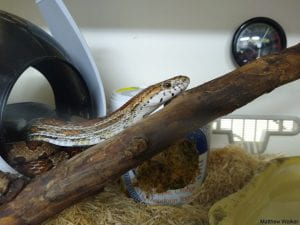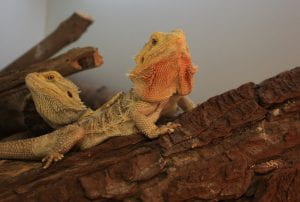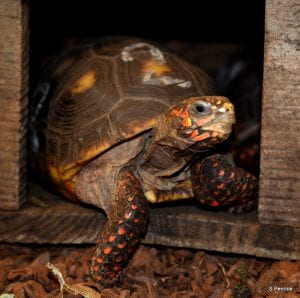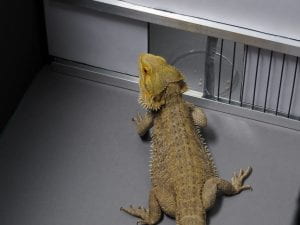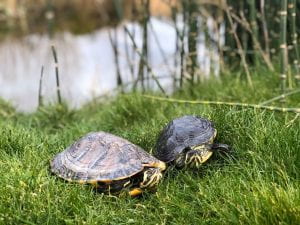Reptiles have traditionally been viewed by scientists and the public alike as beingsluggish, inert and unresponsive and therefore there has been little research investigating their welfare in captivity. Our research into reptile cognition – the study of mental abilities such as learning and memory – has revealed remarkable intelligence in this group, with reptiles performing comparably to (and in some cases more impressively than) mammals and birds. For example, they can learn from each other, remember information for 18 months and can even use a touchscreen! This guide aims to highlight some areas where simple changes to husbandry that incorporate our understanding of reptile cognition and welfare can maximize your pet’s health and wellbeing.
So far, the research has only been conducted with a few different reptile species. However, in the absence of evidence to the contrary, we should assume that all reptiles might be similarly capable and should consider their welfare in light of this. Advice is therefore written in general terms for all reptiles, even though differences between species, and between individuals of the same species, will necessitate the ‘tailoring’ of housing and husbandry to match individual needs and ensure benefits to welfare.
HOUSING
Enrichment impacts welfare and cognition in reptiles. It is important to add enrichment to your reptile’s enclosure. When given a choice, reptiles prefer enriched enclosures. The enrichment you choose should help promote their natural behaviours e.g. branches or a climbing frame for arboreal species or appropriate substrate to allow digging for those species that dig.
Evidence of impressive learning, memory and cognitive flexibility emphasises the need for captive reptiles to experience cognitively complex housing. Housing should contain appropriate enrichment (the specifics of this will differ across species), that providessufficient complexity to ensure an interesting and stimulating environment that allowsthe animals choice, control and the opportunity to exhibit a wide range of species-specific behaviour. For example, providing a range of shelter types placed in severaldifferent locations will give animals more control and choice over where they decide to rest and will also encourage exploration.
Reptiles can perceive pictures (and some models) as if they are the real object. Thisprovides clear and easy enrichment opportunities for your pet. You can make visual changes in reptile enclosures by introducing photographs or videos – this could be of vegetation or simply something novel and interesting. You could also use odours in a similar way. However, this should only be used in addition to physical enrichment within the enclosure and not as a replacement, and, as with all enrichment, should be monitored to ensure that there are no negative effects (e.g. a failure to emerge from shelter).
Reptiles show impressive spatial learning and can remember where things are for a long time. It is important to ensure that your pet’s enclosure has spatial continuity of key resources (e.g. shelters remaining in the same location to create a familiar ‘safe place’) and that your enclosure is spatially complex (e.g. lots of different enrichment items using horizontal and vertical space, where appropriate) for the animals. For some individuals, changing the position of furnishings around the enclosure can encourage exploration (e.g. moving rocks/branches).
Reptiles can use social information and can even recognise humans. There is evidence that some reptile owners are as attached to their pets as owners of more traditional species. It is therefore important to build a good relationship with your pet. Enriched animals are better at recognising familiar humans, therefore it is important to provide enrichment as this will help to improve your relationship with your pet. If an animal knows and recognises you, interactions are likely to be more positive for both you and your pet.
FEEDING
Reptiles have food preferences and will work harder to receive their favourite treat. This knowledge can be used to enrich their feeding regime by including occasional treats. In addition, portions of their diet could be given in ways that are more difficult to access (e.g. within a ball or scattered around their enclosure). Food for herbivorous or frugivorous species might be presented as ‘whole food’ rather than chopped up, allowing the animal to use a greater range of behaviours, and experience more of a mental challenge, when feeding. Occasional treats consisting of highly preferred but less nutritional foods may be beneficial (such as fat-rich waxworms, particularly attractive to leopard geckos), However, if given the choice, preferred treats may be eaten at the expense of a more balanced diet – so use sparingly – and be aware that individuals may have slightly different preferences and/or such preferences may change over time.
As we know that reptiles are willing to work for a favoured food, this can be used to train them, both to provide cognitive enrichment (i.e. to get them thinking) and to reduce the stress of important care activities such as being weighed. However, they must be accounted for as part of the daily food intake, and must remain as treats rather than make up a significant proportion of the diet.
HANDLING
Our recent work has revealed that handling for long periods might be stressful for reptiles if they are not used to it. When handling your pet, it is important to give its body the necessary support and for it to become familiar with you. It is best to start slowly by spending time close to your animal but not touching it and then gradually increasing the level of interaction. It is important to give your pet choices and allow it to have the option of being handled or returning to its enclosure. It is beneficial for your animal to be relaxed whilst handled as situations where handling is necessary, like a trip to the vet, will be less stressful.
As we know that reptiles are willing to work for a favoured food, this can be used to train them, both to provide cognitive enrichment (i.e. to get them thinking) and to reduce the stress of important care activities such as being weighed. However, they must be accounted for as part of the daily food intake, and must remain as treats rather than make up a significant proportion of the diet.
GENERAL CARE
Reptiles rapidly learn about signals that result in different outcomes. This tells us that they can learn what predicts important events in their life, like feeding time! Therefore, using clear signals to allow your pet to predict upcoming events is likely to improve their welfare. Reptiles generally have good colour vision and are able to differentiate between coloured shapes – and so these can be used as signals. For example, differently coloured cue cards could be placed in their view to tell your pet what they should expect to take place in the next few minutes e.g. a red circle shortly before feeding time, a yellow diamond before cleaning out, and a blue square before positive interaction with their owner. Keep in mind that unpredictable use of signals could result in frustration if an expectation (e.g. imminent food arrival) is then not met. Visual signals may be less relevant to some species, so you could use an auditory signal instead, like a word or a tone or even a gentle vibration. Snake owners could “tap train” their snakes, tapping on the vivarium door before opening it, to cue a handling session. The snakelearns that the next event is neither feeding nor a threat.
Reptiles have substantial long-term memory. This tells us that reptiles can remember various different types of information, both good and bad, for a very long time. As such, even brief experiences of inappropriate housing, poor husbandry or necessary, but stressful, events (e.g. a veterinary procedure), could have a long-term impact on their welfare. However, having a good memory also allows individuals to remember positive experiences and retain useful information, such as where food and shelter are located and even the identity of their regular handler. It is important to keep this in mind when they need to experience something for the first time, like travel or visiting the vet. Try to make these experiences as pleasant for your animal as possible so that they form positive memories e.g. if a vet needs a saliva sample from a tortoise, it is better to get them to open their mouth with a tasty treat rather than trying to force their mouth open.
INDIVIDUAL DIFFERENCES
Small differences in early life experience (e.g. incubation temperature) impact onindividual behaviour for the rest of their lives. This can alter traits such as boldness, foraging success and intelligence. Therefore, different individuals of the same species are likely to respond differently to the challenges faced in captivity. Although there aregeneral species-specific requirements for housing and husbandry in order to maximise welfare, it is important that you consider your pet at an individual level. You know your reptile best and should take time to understand their personality and ‘tailor’ aspects of housing and husbandry to match. For example, ‘bold’ individuals may seek out more opportunities for exploration, which can be provided by regularly changing enrichment, whilst ‘shy’ individuals may prefer more hiding places and a more consistent and unchanging environment. Better foragers may require more challenges at feeding timeand more intelligent animals may require more environmental complexity. Make sure you watch how your animal responds to different situations to ensure that they are benefiting from the change, because individuals will vary in their response to different enrichments.
HOW DOES YOUR PET REPTILE FEEL?
Reptile behaviour can tell us how they feel. Reptiles can feel emotions and moods, so it is important to learn how to read their behaviour. In some situations reptiles can show similar behaviours to mammals and bird species when anxious, such as ‘freezing’ when startled or exposed to novelty. But reptiles can also express a range of species-specific behaviours when anxious, such as tortoises pulling their heads/necks into their shells and bearded dragons increasing their frequency of tongue flicking. These behaviours will differ between species and it is important to consider what signs to look for when assessing how your pet is feeling. Any changes in behaviour are often a sign that something is not right, so make sure that you watch your pet reptile carefully and get to know what is normal behaviour for each individual so that you notice and can respond to changes quickly.
REFERENCES
Burman, O. H. P., Collins, L. M., Hoehfurtner, T. & Wilkinson, A. (2016). Cold-blooded care: understanding reptile care and implications for their welfare, Testudo, 8(3), 83–86.
Burman, O.H.P., Hoehfurtner., T. & Wilkinson, A. (2020a). Does the provision of ‘enrichment’ improve the behaviour and welfare of captive corn snakes? RSPCA report.
Cauchoix M, Chow PKY, van Horik J, Atance CM, Barbeau EJ, Barragan-Jason G, Bize P, Boussard A, Buechel SD, Cabirol A, Cauchard L, Claidière N, Dalesman S, Devaud JM, Didic M, Doligez B, Fagot J, Fichtel C, Henke-von der Malsburg J, Hermer E, Huber L, Huebner F, Kappeler PM, Klein S, Langbein J, Langley EJG, Lea SEG, Lihoreau M, Lovlie H, Matzel LD, Nakagawa S, Nawroth C, Oesterwind S, Sauce B, Smith E, Sorato E, Tebbich S, Wallis LJ, Whiteside MA, Wilkinson A, Chaine AS, Morand-Ferron J (2018) The repeatability of cognitive performance: a meta-analysis. Phil Trans Royal Soc.
Frohnwieser, A., Willmott, A. P., Murray, J. C., Pike, T. W., & Wilkinson, A. (2016). Using marker-based motion capture to develop a head bobbing robotic lizard. In International Conference on Simulation of Adaptive Behavior (pp. 12-21). Springer International Publishing.
Frohnwieser, A., Murray, J.C., Pike, T.W., & Wilkinson, A. (2017). Lateralized eye use towards video stimuli in bearded dragons Pogona vitticeps. Animal Behavior and Cognition, 4(3), 340–348. doi:10.26451/abc.04.03.11.2017
Frohnwieser, A., Murray, J.C., Pike, T.W., & Wilkinson, A. (2018) Perception of artificial conspecifics by bearded dragons (Pogona vitticeps). Integrative Zoology.
Haddon, C., Burman, O. H. P., Assheton, P., & Wilkinson, A. (submitted to Anthrozoos) Love in cold blood: Are reptile owners emotionally attached to their pets?
Hoehfurtner., T., Wilkinson, A., Moszuti, S.A., & Burman, O.H.P. (submitted to PNAS) Reptiles experience mood states.
Kis, A., Huber, L., & Wilkinson, A. (2015). Social learning by imitation in a reptile (Pogona vitticeps). Animal Cognition, 18(1), 325-331.
Matsubara, S., Deeming, D.C., & Wilkinson, A. (2017) Cold-Blooded Cognition: New Directions in Reptile Cognition. Current Opinion in Behavioral Science, 16, 126-130.
Moszuti, S. A., Wilkinson, A., & Burman, O. H. (2017). Response to novelty as an indicator of reptile welfare. Applied Animal Behaviour Science, 193, 98-103.
Mueller-Paul, J., Wilkinson, A., Hall, G., & Huber, L. (2012)a. Radial-arm-maze behavior of the red-footed tortoise (Geochelone carbonaria). Journal of Comparative Psychology, 126(3), 305–317. http://doi.org/10.1037/a0026881
Mueller-Paul, J., Wilkinson, A., Hall, G., & Huber, L. (2012)b. Response-stereotypy in the jewelled lizard (Timon lepidus) in a radial-arm maze. Herpetology Notes, 5, 243–246.
Mueller-Paul, J., Wilkinson, A., Aust, U., Steurer, M., Hall, G., & Huber, L. (2014). Touchscreen performance and knowledge transfer in the red-footed tortoise (Chelonoidis carbonaria). Behavioural Processes, 106, 187–192. http://doi.org/10.1016/j.beproc.2014.06.003
Nagabaskaran, G., Burman, O.H.P., Hoehfurtner., T., & Wilkinson, A. (submitted to Applied Animal Behaviour Sciences). Environmental enrichment enables discrimination between familiar and unfamiliar human odours in snakes.
Santacà, M., Miletto Petrazzini, M. E., Agrillo, C., & Wilkinson, A. (2019). Can reptiles perceive visual illusions? Delboeuf illusion in red-footed tortoise (Chelonoidis carbonaria) and bearded dragon (Pogona vitticeps). Journal of Comparative Psychology.
Siviter, H., Deeming, D. C., Rosenberger, J., Burman, O. H. P., Moszuti, S. A., & Wilkinson, A. (2017). The impact of egg incubation temperature on the personality of oviparous reptiles. Animal Cognition, 20(1), 109–116. http://doi.org/10.1007/s10071-016-1030-1
Siviter, H., Deeming, D. C., van Giezen, M. F. T. & Wilkinson, A. (2018). Incubation environment impacts the social cognition of adult lizards. Royal Society Open Science
Siviter, H., Deeming, D. C., & Wilkinson, A. (2019). Egg incubation temperature influences the growth and foraging behaviour of juvenile lizards. Behavioural processes.
Soldati, F., Burman, O. H. P., John, E. A., Pike, T. W., & Wilkinson, A. (2017). Long-term memory of relative reward values. Biology Letters, 13(2), 20160853. http://doi.org/10.1098/rsbl.2016.0853
Stockley, V., Wilkinson, A., & Burman, O.H.P. (in press) How to handle your dragon: Does handling duration affect the behaviour of bearded dragons (Pogona vitticeps)? Animals
Wilkinson, A., Sebanz, N., Mandl, I., & Huber, L. (2011). No evidence of contagious yawning in the red-footed tortoise Geochelone carbonaria. Current Zoology, 57(4), 477–484.
Wilkinson, A., & Huber, L. (2012). Cold-Blooded Cognition: Reptilian Cognitive Abilities. The Oxford Handbook of Comparative Evolutionary Psychology, 1–15. http://doi.org/10.1093/oxfordhb/9780199738182.013.0008
Wilkinson, A., Mueller-Paul, J., & Huber, L. (2013). Picture-object recognition in the tortoise Chelonoidis carbonaria. Animal Cognition, 16(1), 99–107. http://doi.org/10.1007/s10071-012-0555-1
Wilkinson, A., & Glass, E. (2018) Cold-blooded Cognition: How to get a tortoise out of its shell. Field and Laboratory Methods in Animal Cognition. Cambridge University Press, UK.
Wilkinson, A., & Glass, E. (in press) Testudines Cognition. The Encyclopedia of Animal Cognition and Behavior. Springer Nature, USA.
These guidelines were written by Professor Anna Wilkinson and Professor Oliver Burman (University of Lincoln). They have been endorsed by the cold-blooded care working group. This group comprises of animal charity representatives, representatives of the reptile industry and specialist vets.

